“Mora mora Vazaha” is the first Malagasy expression that we learn to use. It is the equivalent of the Italian “Chi va piano, va sano e va lontano.” “Mora mora” is a state of mind, a certain languor, a way of life. Upon arrival in Madagascar, forget your stress, learn to wait, get neither excited not worry about wasting time, but you never really waste time. Mora mora, slowly, slowly, it is how people live in Madagascar. If you fight mora mora, you will be quickly frustrated. In short, at your arrival at Antananarivo airport or Tana, you begin learning Mora mora Vazaha. Vazaha means white person in Malagasy. Your colleagues from the plane are waiting just like you. Your bags are already on the carousel, but the line to get your passport duly stamped with the entry visa is still long. Everything is handwritten, including the visa in your passport. Only two officers work at the immigration for passengers from a plane with 470 seats. There is plenty of time to admire an ad for a telephone operator with the outline of a lemur on a black background. We smile. The journey has just begun…
Madagascar, the Big Island, is the fifth largest island in the world with a total area of 226,597 square miles. In 2012, the Malagasy population was estimated at just over 22 million. The capital Antananarivo, with 1.6 million, is the largest city of the island, and also known by its shorter French colonial name, Tana. Madagascar is an Island-continent in the Indian Ocean off the coast of Southeastern Africa and separated from Africa by the Mozambique Channel. Madagascar is also known as The Red Island, referring to the colored laterite plateau. Behind all these nicknames Madagascar is home to an abundant biodiversity of unique wildlife found nowhere else on Earth and a mosaic of ethnic groups. The diversity of scenery is superb, the fauna and flora surprising. About 90% of all plants and animals are endemic, including the famous lemurs. The Malagasy represent eighteen official ethnic groups perpetuating traditions of people who came from Southeast Asia and East Africa and whose customs still fascinate anthropologists today… but “Mora mora“…

The Highlands
Our discovery of the island begins with the Highlands to the south of the capital. Right out of Tana the rice fields and picturesque villages of the Highlands characterize the landscape. Why “Highland”? Just because it is the signature landscape of Madagascar. At about an elevation of 4,186 feet above sea level, it is a landscape unlike any other, constituting of hills and rocky ridges, hillside villages, tall brick houses with thatched roofs, and valleys with rice fields. Women transplant rice plants in rows, giving the impression of a small corner of Asia on African soil! Malagasy cuisine consists of a base of rice reflecting the influence of various ethnic groups that have settled on the island. We eat rice three times a day (MMS dixit Yvon our guide – Morning, Midday, Evening) except during difficult times. Between two successive harvests of rice, cassava, sweet potato, and taro are partial substitutes for rice. It is for this reason that it seems we are contemplating a palette of colors when we observe cultivated plots on the Highlands.

The Highlands – Rice fields
Going from village to village and hut to hut we meet local farmers and artisans. In Ambatolampy in the Central Highlands 80 kilometers from Tana, there is a center for the manufacture of the handicraft-recycled aluminum cook pot found in every Malagasy home: everything from a mini-casserole for salt or pepper to a “giant” pot for cooking rice for a family of 15. This is our first “jump into the past.” First of all, the aluminum used comes mainly from aluminum residues: wheel rims, car parts, etc… In the courtyard, people collect items to be melted in a brick oven, and the molten aluminum is then transported to a small room. There craftsmen, working without any safety protection, prepare the production of cooking pots lifting barehand containers containing the blazing hot metal ! A little further, we discover raffia crafts, made with leaves of Raffia ruffia, a native palm of Madagascar. We continue to Behenjy where we taste Malagasy Foie gras (I’m not joking).
The preferred means of transportation in Madagascar is bus line 11, always over-crowded and over-loaded with bags and, as you can easily guess, the 11 represents the drawing of your two legs when walking. For longer distances, the fashionable and, but still affordable, means of transportation is the taxi-brousse. The taxi-brousse is always overloaded both by passengers (sometimes some hanging on the sides of the vehicle) and in bric-a-brac on the roof (as many boxes, bags, groceries, poultry, mopeds and motorcycles as possible up to a height of 5 feets. The taxi-brousse runs day and night. At night to take advantage of the cool air and also to avoid the heat from the overheated of the engine as well as to avoid police, army and gendarmerie road controls which are very frequent on the RN7. During these inspections, the “representative of the law” takes the vehicle documents, goes to the back of the papers, takes the money “hidden” there and then authorizes the driver to continue his journey. “Bakchich” is commonplace !

Taxi Brousse
For short trips, Malagasy opt for a bicycle (up to 4 people on one bike–pardon me, 5–I forgot “God,” always present as an additional passenger – “Jesus is coming, Jesus is coming, Jesus comes among your people. From the top of the cross, he shows us the way you know so well.” A free translation of the lyrics of French singer Patrick Bouchitey in the 1988 comedy “Life Is a Long Quiet River.” Families with means opt for a zebu cart when the family is wealthy enough to have zebu. All these different modes of transport coexist on the roads by day and night without lights of course!
Antsirabe, the hot spring city and third largest in Madagascar, is 110 miles from the capital Tana. We take a short city tour by pousse–pousse or rickshaw, the primary means of transportation for Antsirabéens. In 1917, the first thermal baths opened in Antsirabe resulting in the construction of major buildings such as the Thermal Bath Center in 1917 and the Hôtel des Thermes in 1922. We visit the local market where everything either measured “large scale” in an empty can of sweetened condensed milk or “small scale” in an empty can of condensed tomatoes, except for some fruits and vegetables which are weighed (bananas do not fit into the small or large tin!). Besides, when they are not used as “scale”, these tins become miniature handicrafts for cars, bicycles… In Madagascar nothing is lost, all objects have many lives. Another striking example, bicycle wheel rims make excellent tv antennas… a thousand times better than a rake antenna according to Yvon our guide.

Antsirabe – Local market
For the rest of the journey, our barge “La Sirène” and its crew are waiting for us on the river Tsiribihina, which flows through Tsingy de Bemaraha National Park in western Madagascar. After leaving the Highlands and boarding “La Sirène,” we follow the river down to Tsingy of Bemaraha National Park. Large and quiet, the Tsiribihina River and its meanders are a perfect setting to discover Madagascar at a more natural Mora mora pace. I hope you have not forgotten that Madagascar is the country of Mora Mora ! The surrounding landscapes are varied as we sail. First an arid area almost without vegetation, then crops, tobacco, forest, gorges, sandbanks, and finally the first baobabs. It is also during this descent that we encounter our first lemurs (Lemur Rufus) during a stop at a beautiful waterfall. There are also many birds to watch on the river banks sandbanks: herons, egrets, knob-billed duck, kingfisher malachite… and some immobile crocodiles enjoying the warmth of the afternoon sun on the riverbank.
Apart from the wildlife, this trip is also an opportunity to meet people living alongside the river and to observe their daily life, rice and tobacco plantations, herds of zebu and fishing, but also toilet, cooking, traditional cuisine and laundry “sandblasted” on the river bank. A stop to visit the village of Begrido where children warmly welcome, perhaps too warmly. Villages along the River are accessible only by the river: canoe and river taxi-brousse are just as crowded and loaded with bric-a-brac as their cousins on the road!

River Tsiribihina – Sunset
We stop every evening just before a magnificent sunset and camp on a huge sandbar without light, but the stars are so bright… Evenings are organized around a campfire with the crew playing guitar, singing local songs, and dancing. Such a delightful atmosphere! After two and a half days on this long quiet river, we dock in Belo / Tsiribihina and leave the crew of “La sirène.” A four-wheel drive vehicle is waiting for us… En route, if we can call it that (the road is nothing like a road but more like a rodeo ride), to Tsingy of Bemaraha.

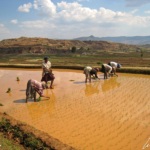

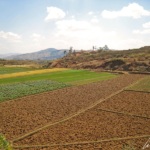

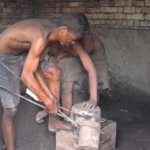
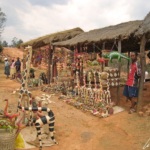
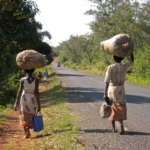
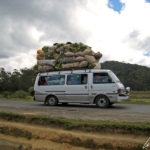
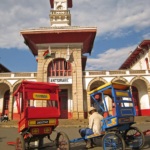

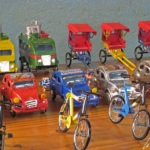

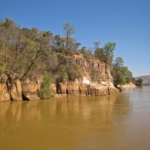
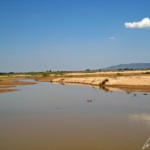
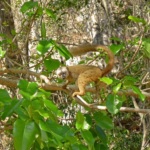
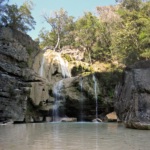

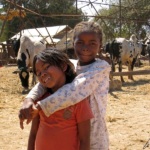

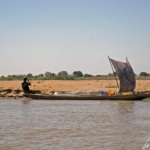
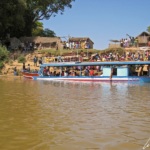

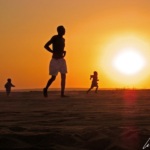
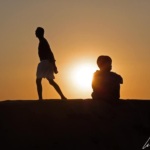


I love your pictures. You’ve captured the essence of the surroundings. We’ve been meaning to visit Madagascar but we don’t seem to have enough time !
Madagascar is unlike anywhere I have been to: fantastically beautiful, amazingly diverse for its size and still so unspoiled. This country is also called the eighth continent: it has an incredible range of habitats only hours apart, all within the same country (from the wettest rain forest to the driest desert, within hours).
Great post and lovely pictures. Madagascar is on my list. I hope I could go there soon. The information and your explanation are awesome and helpful. Seems you had a great time 🙂
Madagascar is undeniably one of those destinations where you can say “I don’t make a trip; the trip makes you”.
Incredible photos. What an experience. Madagascar looks so varied and beautiful.
Thank you 🙂 There is something very different about this country. I guess Madagascar would fit into those unparalleled, strange places that don’t have much to do with other continents…
wow, what an experience! would love to go to madagascar one day and see all this for myself. =)
I can really describe it as the most fascinating and beautiful country I’ve ever been to. It is a place that completely has its own vibe; it’s not African, or Asian or European but then, at the same time, it is all those things…
Sounds like an amazing experience! I would love to visit Madagascar. Loving all your photos! 🙂
Thanks 🙂 Jungle, dry forests, deserts and xeric shrublands, high peaks, escarpments and plateaus, swamps and lagoons – Madagascar has it all. For the size of the island, Madagascar has an overwhelming amount of stunning and diverse landscape. It is a stunning experience !
This looks beautiful! I so can’t wait to visit Africa 🙂
With it’s unbelievably breathtaking natural allures, Madagascar should definitely be on your bucket list. If it’s not, it soon will be…
Wow, your pictures should be in a Nat Geo magazine! They are stunning and you captured it all so well. It definitely sounds like you had an incredible experience in Madagascar – the bus and bicycle trips would have been a shock to me!
Thank you 🙂 If you want to travel around the country independently, taxi-brousses are your best bet. These shared minibuses, packed in a way that you didn’t believe was possible, run pretty much everywhere in the country. On one hand, they cost peanuts, but on the other, rides can be long, uncomfortable and possibly dangerous… 🙁
I feel like there is not nearly enough content on Madagascar out there, so thanks a bunch for this article! I actually briefly considered it as our honeymoon destination, haha. It didn’t work out this time, but I’d still love to visit. You photos really inspire me, it looks like such a unique place 🙂
Thank you 🙂 To say the trip was magical would be the complete truth. You will see things here that will blow your mind. Not only will see the most beautiful wildlife but you will change as a person… you perspective on life will definitively change !
I really like the pictures, really gave me that wanderlust! You have that human factor in all of them, which is really nice. Super! I am really fascinated by rice paddies and local markets. I am planning a trip to Japan to photograph the whole cycle of cultivating rice. Madagascar seems like a very interesting place, one which I would love to add to my list.
I have never been to Japan and it’s still one of the top countries to visit on my bucket list ! There are many people who describe Madagascar as a half-finished world. I think this is a very accurate description of the strange, weird and wonderful landscapes, creatures and plants that call this land their home. Nearly everything you see here is found nowhere else in the world. The scenery is spectacular and the biodiversity is exceptional !
Madagascar is certainly on our travel wishlist! The way you describe the taxi-brousse reminds us of danfos in Nigeria. It all seems hectic, but it works for so many cities and is a staple in the transportation systems in each one.
Transport in Madagascar (by taxi-brousse) is not always very confortable, but travelling around that way on a budget is certainly not difficult for anyone who is used to travel that way and I would even say that it’s very much part of the fun 🙂 Madagascar should definitely be on your bucket list. If it’s not, it soon will be…
What an insightful article! I would absolutely love to visit Madagascar, it seems like such an underrated place rich in culture. Also love the concept of mora mora. In Tanzanian its the exact same concept but the saying is ‘pole pole’.
“Pole, pole” or “Mora, mora” or “Chi va piano, va sano e va lontano” is really a state of mind, a certain languor, a way of life… Forget your stress, learn to wait, get neither excited not worry about wasting time, but you never really waste time ! I love this philosophy 😉
What a beautiful picture of Madagascar you’ve painted. I love how you’ve woven in the language, culture, and really captured the essence of what Madagascar is. So well done!
Madagascar has some truly fascinating cultural excursions on offer especially the importance of ancestors in peoples’ day-to-day life and the interesting attitudes people hold towards death. The tribalism of Madagascar is a very interesting story in itself and one will have the opportunity to learn about the different tribes, their way of life and how they have grown to live in the areas where they do now 🙂
Loved your post and beautiful photos! I feel like not many people (bloggers) have been to Madagascar, so your post is definitely so useful.
Thank you 🙂 Madagascar offers the complete package for visitors, with a wonderful blend of interesting and unique experiences, beautiful scenery and fantastic guiding.
Madagascar sounds like an absolutely stunning experience that awaits us as we love the languid pace of life. I can only imagine the experience of hopping from hut to hut and meeting local farmers and artisans. So dreamy!
Without a doubt one of the major drawcards of the island are the stunning and ever-changing landscapes that it offers ! The ever-changing topography is something that you are bound to find captivating. It’s possible to visit a variety of villages in both the coastal areas and further inland to get an idea of how people adapt to living in the often harsh environments that the island creates.
Madagascar overall sounds like a wonderful island destination. It’s as if the island is a whole different world of its own. Beautiful captures, especially the sunset picture and the one of ladies in the paddy fields.
Thank you 🙂 Lemurs, baobabs, rainforest, desert, hiking and diving: Madagascar is a dream ! For visitors looking to enjoy a quintessentially African experience, sundowner drinks on the west coast’s Avenue of the Baobabs is a hard experience to beat 🙂
wow your photos really bring it to life, especially the first picture. I would love to visit one day.
Thank you 🙂 With it’s unbelievably wildlife and breathtaking natural allures, Madagascar should definitely be on your bucket list. If it’s not, it soon will be…